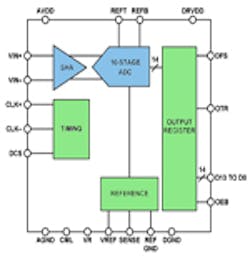2012: Intelligent Data Converters Power Next Evolution of Energy-Efficient Designs
The number and complexity of sensors is growing rapidly around the world. Advances in signal processing and a growing set of applications. Many of these multi-domain sensors, for instance, require sophisticated, precision signal acquisition that can differ considerably from sensor to sensor.
In the next two years, two themes that will illustrate this trend are the rapid expansion of advanced sensors in parallel with converter core technology development, and the movement toward embedding continuously adjustable power features in the data converter.
In addition to the industry mainstays of a general awareness of "green" design benefits, legislation and cost considerations, another major trend in the data converter segment is the need for longer battery life, which will be discussed later in this article.
The continued move to put more "smarts" into data converters is expected to be one of the major data conversion trends in 2012. By managing additional system functions, these smart converters will not only allow designers to use smaller, simpler, more cost effective data processors, but they will also make programming easier and improve overall system performance.
Customers are frequently designing in the converter core and sensor IC simultaneously and as an integrated unit. In fact, system design engineers seek to optimize sensor performance by viewing the sensor-converter as a single unit, both in terms of analog signal acquisition as well as digital post processing requirements. This minimizes the cost and also optimizes the sensor performance by having a converter that "gets the most" out of the sensor element.
Due to this increasing level of integration, these enhanced "digital sensors" have all kinds of design advantages or "smarts." The converter can use internal calibration and linearization routines to process sensor outputs. Sensor gain and offset can be corrected by the converter and on-chip sensor excitation signals can be created. Digitally managed programmable gain amplifiers can be used to "optimize" the converter to a particular sensor reading and then reconfigure to read a different signal from the same sensor. Thermal errors can be accounted for and removed by including temperature monitoring capability in the converter and adjusting the converter output based on the temperature. MEMS (micro-electromechanical systems) sensors -- typically accelerometers and gyroscopes -- are likewise being combined with data converters to sense inertial and rotational motion and are being deployed in scores of applications ranging from industrial and healthcare devices to mobile phones and automobile stability control systems. In short, designers are achieving improved time-to- market and, in many cases, performance, because less of their attention is spent on detailed sensor performance problems.
The diversity of applications is leading to new converter technologies that are able to intelligently convert sensor inputs of different magnitudes and signal types with minimal pre-conditioning.
Moreover, given that the sensor signal is typically small enough to be corrupted by noise, the ability to co-locate the converter and sensor means that the signal now travels microns not feet, making sensor calibration easier and more reliable. As system design becomes more heavily dependent on integrated sensors, the converter needs to be even more sophisticated and functional. As the converter's importance in the overall system grows, a greater emphasis is placed on designers to meet system redundancy and functional safety concerns, requiring deep converter understanding to ensure these issues are appropriately managed.
Regarding the achievement of longer battery life, continuously adjustable power represents the next step in the evolution of low power design as converters become intelligent enough to constantly regulate and adjust system power. Here, a converter needs to manage its own and the systems' power requirements, ensuring a proper balance between signal acquisition and power demands. Converters capable of this balance will enable more efficient energy management for electrical and hybrid-electric vehicles, better management of power transmission grids, improved CT (computed tomography) and digital X-ray imaging, and faster wireless data communications.
The advent of an embedded constantly adjustable power function is the logical evolution of the power-down pins of a decade ago and the more recent power vs. performance tradeoffs we've see in many data converter designs. These new features will require both design and manufacturing innovation, such as finer line lithography processes that use digital techniques to augment core analog capabilities.
Continued integration will yield better performance and, in many cases, alleviate issues associated with system-level design partitioning - while simultaneously reducing design cost, complexity, and board space. Because of the crucial role they play in faithfully reproducing real-world phenomenon, today's data converters are constantly evolving to achieve the most lifelike user experiences possible.
